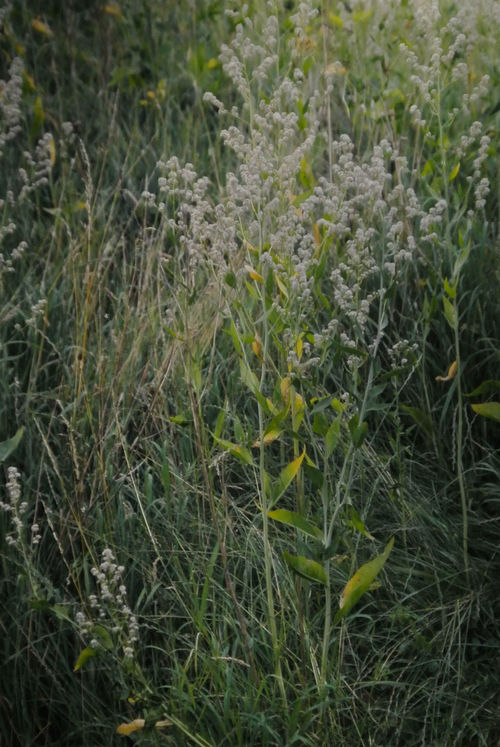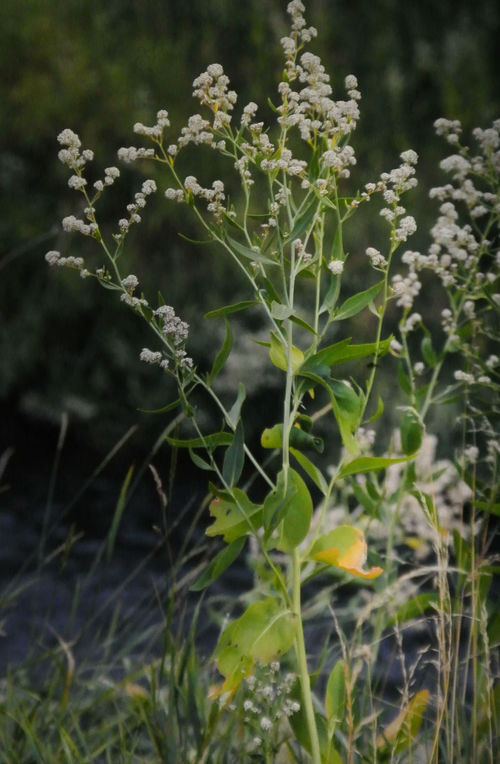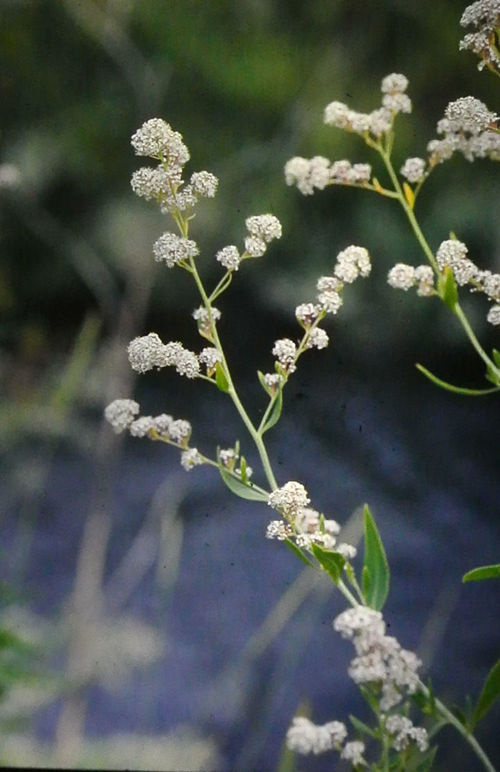Dittander Lepidium latifolium L. at Droitwich
Geoff Trevis
Introduction
Dittander Lepidium latifolium is a rather unprepossessing, perennial plant with fleshy leaves and an inflorescence of small white flowers, which grows to a height of about 1.5m. It belongs to the halophyte (salt tolerant) group of plants. This does not mean it requires salty conditions to grow but rather that it has a competitive advantage in salt marshes. It is widely distributed in Britain though away from its natural locations it is not common. Its alternative name, Pepperwort, gives the clue to the distribution. Its leaves are said to be an excellent addition to salads and it may, therefore, have been planted as a culinary herb.
In Worcestershire it is very uncommon, being restricted to the Salwarpe valley, mainly on the banks of the river Salwarpe, between Drotwich Spa and Hawford. In times past the area south of Droitwich Spa to Salwarpe was a salt marsh, resulting from the Droitwich salt industry, which contained many halophytes in addition to Dittander. John Amphlett’s contribution on botany in the Victoria History of the County of Worcester simply states that among other halophytes L. latifolium grows abundantly by the Salwarpe at Droitwich.
History
The first record of dittander in Droitwich was made by Rev. J.H. Thompson in 1852 (formally reported in 1853) when he says “Last October, I had the pleasure of adding to the Worcestershire Flora, L. latifolium, which I found close to the river Salwarpe, where it is crossed by the Wolverhampton Railway near Droitwich. I first saw some patches of it on the recently-formed railway embankment; but on further examination I detected some old plants in a muddy place by the river-side, where, perhaps, they have been growing secluded and unnoticed for a long time”.
Edwin Lees (1854) confirms this when he says that dittander grew “on the banks of the Salwarpe at Droitwich, just where the railway to Stoke crosses the river” and that it was discovered by the Rev. J.H. Thompson “who pointed out a large patch of the plant to me there in 1852”. At this point I cannot help but take a slight diversion to give a flavour of Lees’ description of the site, “pepperwort was found at a spot where the river, loaded with garbage, slowly emerges from among the sooty chimneys of murky Droitwich”! Interestingly, there is a slight difference between these two reports. Thompson says he found it by the bridge where the Wolverhampton Railway crosses the river whilst Lees says it was by the bridge where the Stoke line crosses the river – these are, I suspect, different branches as the Wolverhampton line would be the one going to Stourbridge whilst the Stoke line is that going to Birmingham via Bromsgrove. In another of his books, written in 1867, Lees again notes L. latifolium at Droitwich with the description “On inspecting the locality, though the plants on the railway embankment appeared of recent origin, yet old seedy plants by the side of the dingy Salwarpe looked as if they had grown grimy there for many a year”.
The Worcestershire Naturalists Club made many visits to the Salwarpe Valley, walking the canal and river to Hawford and making small diversions to interesting local sites including Westwood Park. In 1880, their Transactions record that “The very uncommon Broad-leaved Pepperwort (Lapidium latifolium) was, however, found in its old habitat on the railway embankment near Droitwich”. A similar record is found from a visit in 1934 where the plant was found “near the canal bridge at the old wharf” and in 1943 the first record near to its current location at Briar Hill Coppice, when “several nice examples” were noted on the approach to Briar Mill (this is near Droitwich High School and should not be confused with the reserve at Briar Hill). In 1951 Fred Fincher wrote an article for the Transactions of the Worcestershire Naturalists Club about the maritime plants with records between Porter’s Hill Farm and Droitwich, growing along side the river, included Dittander.
A report in 1954, whose origin I have been, so far, unable to attribute notes a recommendation by F. Fincher that the salt marsh area should be scheduled as a Site of Special Scientific Interest (SSSI). There is another rather interesting record from 1967 saying that a drainage scheme implemented by the Borough Surveyor affected part of the site and the Trust (which?) arranged to move individual plants of Dittander to another, safer part of the site. The SSSI designation came into force in 1972 following a further report by Fred Fincher in 1970 that records “along the banks of the Salwarpe there is also a fair amount of Dittander, one of the most interesting halophytes for which the area was noted. About seven main sites still remain and it appears in no danger”. It is, however, difficult to pin down exactly where the plants were. Since 1972 drainage, cultivation and dumping of top soil, combined with the demise of the salt industry gradually reduced the salt marsh and the SSSI was de-scheduled in sections.
Large stands of Dittander were photographed near Briar Hill Coppice Reserve in July 1980 growing adjacent to the Salwarpe (01, 02, & 03). The pictures are converted from old Kodak transparencies.
A report of a river corridor survey of the Salwarpe in 1992 to National Rivers Authority notes that “Lepidium latifolium (Dittander) is a common component of open stretches of tall herb habitat along the banks of the Salwarpe downstream of Droitwich” and its positions are indicated on the sketch maps of each section surveyed (Castle 1992).
Roger Maskew (2014) also records several references to Dittander in the literature. In particular, he notes “In what is now accepted in Preston et al. (2002) and Stace et al (2003) as its most inland British native site, Dittander is at present scattered and locally frequent along the banks of the Salwarpe from Hawford (SO8460) to Netherwich (SO8963) but apparently not seen further east along the river in SO96 since the 1980’s.” Most interestingly he also records a large stand over some 10 m on the slip road of the M5 at Wychbold (SO9165) in 2009!
The Source of Dittander
The origin of Dittander at Droitwich which, as noted earlier, appeared some time before 1852, is uncertain. Lees (1854) and Thompson quote the idea of Prof. James Buckman that the presence of halophytes around Droitwich, and some other places along the Severn flood plain, “affords good evidence that marine conditions once prevailed along the greater part of the Severn, and that the marine waters were far wider than the reach of even the floods of our day”. However, it was also suggested that the plants arrived with barges coming up the canal from the Severn estuary, particularly from Bristol. Amphlett and Rea (1909) take another view, that the plant is an escape from local cultivation. The evidence for transport from Bristol or for garden escape is not strong either way but I would think that its survival over a long geological period, possibly since shortly after the last ice age, is less likely.
The current situation at Droitwich and Droitwich Community Woods
My own involvement with the site began in about 1984 and I have known Dittander growing quite profusely on either side of Ombersley Way where the road crosses playing fields and the Briar Hill Coppice reserve (now part of Droitwich Community Woods). Records held by WBRC show its presence in the Salwarpe Valley until 2001, including occasional records along the canal and, indeed, I found a single plant close to the railway bridges over the canal only this year. Nonetheless, over the last few years the number of plants has gradually declined until it became extinct in all its usual Droitwich sites except for some vigorous growth among unmanaged patches of nettles Urtica dioica and brambles Rubus fruticosus agg. close to Ombersley Way on open space belonging to Wychavon District Council, but which is not part of the reserve. I thought this was the end of this important aspect of the Community Woods but more recently I was surveying part of the reserve at the north end, called Appler’s Piece, which has been unmanaged for many years, and was delighted to find good stands of Dittander growing along the banks of the Salwarpe and further into the middle of the area. The vegetation again is dominated by nettles with some brambles, hogweed Heracleum sphondylium, hemlock Conium maculatum, teasel Dipsacus fullonum and some quite striking stands of small teasel Dipsacus pilosus.
The question is, why did the plant persist in some unmanaged areas whilst it died out in other similar unmanaged patches where it had previously been abundant? I can think of no obvious answer to this.
I have found several references to the culinary use of Dittander and its cultivation. In essence it appears that this plant does indeed produce edible leaves which have a hot taste comparable to nasturtium and horse radish and it responds well to being pruned when it produces small, even tastier leaves. The down side is that its root system is even more vigorous than the parts above ground and it produces roots which spread everywhere and send up new shoots in abundance, comparing well with ground elder Aegopodium podagraria and couch grass Elytrigia repens!
This being the case, one can understand why it has persisted so well in some places but does not suggest any reason why it has died out in others. Do we need to introduce some management to ensure its continuing survival? If so, should this simply involve strimming every few years to check nettles etc., should we harvest some plants to encourage new growth? Should we perhaps harvest seed and try to re-establish it in its old haunts? At the moment I am not sure and perhaps we will have to try some limited experiments on small patches to see what happens. Anyway, it is at least good to know that this rare plant continues to thrive at present and has not, as first thought, become extinct at Droitwich Community Woods.
References:
Amphlett, J. & Rea, C. 1909. The Botany ofWorcsetershire. Cornish, Birmingham.
Amphlett, J. 1901. Phanerogamia (Flowering Plants) in The Victoria History of the County of Worcester, Volume 1. Dawsons, London.
Castle, G. 1992, River corridor survey Salwarpe, Worcestershire, June 1992. Unpublished report to National Rivers Authority.
Fincher, F. 1951 Worcestershire Maritime Plants. Transactions of the Worcestershire Naturalists Club 1950/51 10 (4) p. 265-269.
Fincher, F. 1970. A report believed to have been written for the Nature Conservancy Council.
Lees, E. 1856. Pictures of Nature in the Silurian Region Around the Malvern Hills and Vale of Severn: Including Incidental Excursions with the Malvern and Worcestershire Clubs: and Notices of the Natural History, Pictorial Scenery, Botany, Geology, Customs and Superstitions of Many Interesting Localities in Worcestershire and Herefordshire. Lamb, Malvern.
Lees, E. 1867. The Botany of Worcestershire, or the Distribution of the Indigenous and Naturalised Plants of that County, with Descriptions of the most Remarkable Localities for Botanical Observation, Including Sketches of the Physical Geography of Worcestershire in Four Botanical Districts, and a Tabulated Arrangement of Plants, showing their Frequent or Rare Occurrence in each Division. Worcestershire Naturalists’ Club, Worcester.
Lees, E., 1854. Transactions of the Worcestershire Naturalists Club, August, page 11.
Maskew, R. 2014. The Flora of Worcestershire. Published privately.
Preston, C.D., Pearman, , D.A. & Dines, T.D., Eds. 2002, New Atlas of the British and Irish Flora, Oxford University Press, Oxford.
Stace, C.A., Ellis, R.G., Kent, D.H., & McCosh, D.J.. 2003, Vice-county Census Catalogue of the Vascular Plants of Great Britain. Botanical Society of the British Isles, London.
Thompson, J.H. 1853, A note on the Worcestershire species of Lepidium. Phytologist, 4:970.
Transactions of the Worcestershire Naturalists Club 1934 p. 104
Transactions of the Worcestershire Naturalists Club 1943 p. 34
Images
01. Dittander Salwarpe Droitwich July1980. Harry Green.
02. Dittander Salwarpe Droitwich July1980. Harry Green
03. Dittander Salwarpe Droitwich July1980. Harry Green


